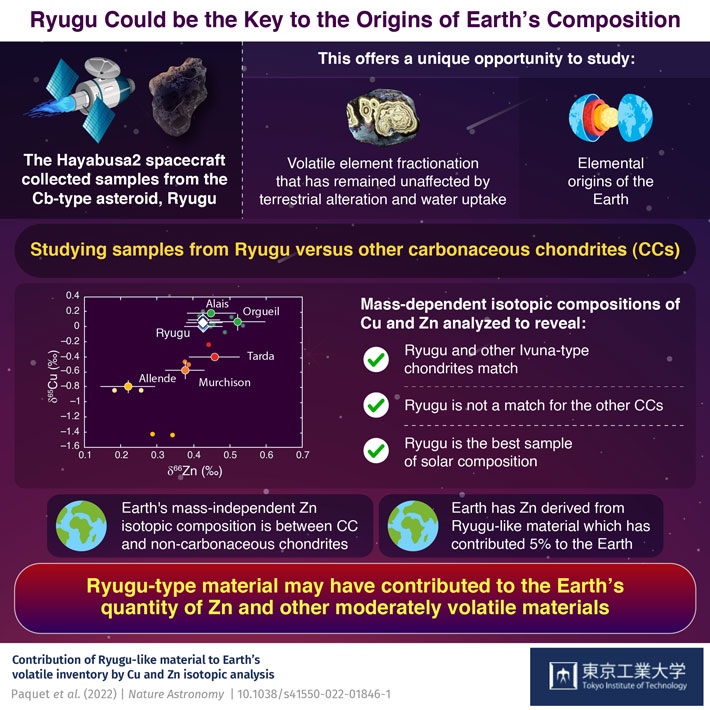The elemental composition of the Earth comes from its fiery past, through accretion of various solar system objects. New samples collected by the Hayabusa2 space mission provide insight into the origins of moderately volatile elements such as zinc and copper. Tokyo Tech researchers have linked the material from the Cb-type asteroid, Ryugu, to the elemental composition of the Earth. Their results suggest that Ryugu-type material played a significant role in the genetic heritage of the Earth’s elemental composition.

Understanding the origins of Earth’s elemental composition offers a glimpse into the history of our planet. One way to learn about this is to investigate the meteorites that would have similar composition with materials that contributed to the accretion of planet Earth in its early development. Meteorites are divided into multiple classes based on their composition. The most primitive and common of these classes includes chondrites, which further includes carbonaceous chondrites (CCs). Of these, Ivuna-type (CI) CCs have an elemental composition that is nearly identical with that of the solar photosphere, which therefore can be used as a key reference for understanding how early solar system processes shaped planets and their building blocks. The Hayabusa2 spacecraft’s mission was to collect samples from the Cb-type asteroid (162173), Ryugu. As the elemental composition of returned Ryugu samples is unaffected by further terrestrial processes, the two successful sampling events on Ryugu offer a plethora of unprecedented information.
Now, a large international research collaboration has delved into the data to extract learnings on the fractionation of volatile elements and their origins on Earth. Their article was published on . Dr. Marine Paquet and Prof. Frederic Moynier from The Université Paris Cité, France, and Prof. Tetsuya Yokoyama of the Department of Earth and Planetary Sciences at Tokyo Institute of Technology (Tokyo Tech) led this research effort. Dr. Paquet and Dr. Moynier measured the Cu and Zn isotopes of Ryugu samples in Paris; Prof. Yokoyama is excited by what they have unveiled. He surmises, “While some early studies and analyses showed that Ryugu’s chemical composition is close to CI chondrites, a deeper analysis suggests otherwise. Some of the isotopic signatures of elements such as titanium and chromium extracted from the Ryugu samples overlap with other CC group meteorites as well as CIs, meaning the link between Ryugu and CI chondrites remains murky and requires further clarification. Our work shows that Ryugu and CI chondrites have the same mass-dependent zinc and copper isotopic compositions, which is a novel finding. All the different chondrite groups have very distinct zinc and copper isotopic signatures, so this parameter can be easily used to detail relations and find similarities. Our results point at a common genetic heritage between Ryugu and CI chondrites, effectively ruling out any affinity with other CC groups. This suggests that Ryugu’s samples are the best available estimate of the solar composition for zinc and copper, something that has thus far been elusive.”
The gold standard result showed that Ryugu samples and all CCs exhibit identical positive mass-independent zinc isotope variations, within error.
“Earth’s mass-independent zinc isotopic composition is somewhere in-between Ryugu or CC and non-carbonaceous chondrites. This suggests that Ryugu-like materials have contribute to the Earth’s quantity of zinc and other moderately volatile elements and are thus an important part of the history of our planet’s composition. We estimate that 5% of Ryugu-like material might have contributed to the Earth’s mass, which is really a substantial amount,” concludes Prof. Yokoyama.
Overall, the isotopic analysis of copper and zinc from Ryugu samples gives us a glimpse into the fiery history of the early days of planet Earth, as well as the solar system.
Reference
Authors : | *Marine Paquet, *Frederic Moynier, Tetsuya Yokoyama, Wei Dai, Yan Hu, Yoshinari Abe, Jérôme Aléon, Conel M. O’D. Alexander, Sachiko Amari, Yuri Amelin, Ken-ichi Bajo, Martin Bizzarro, Audrey Bouvier, Richard W. Carlson, Marc Chaussidon, Byeon-Gak Choi, Nicolas Dauphas, Andrew M. Davis,Tommaso Di Rocco, Wataru Fujiya, Ryota Fukai, Ikshu Gautam, Makiko K. Haba2, Yuki Hibiya, Hiroshi Hidaka, Hisashi Homma, Peter Hoppe, Gary R. Huss, Kiyohiro Ichida, Tsuyoshi Iizuka, Trevor R. Ireland, Akira Ishikawa, Motoo Ito, Shoichi Itoh, Noriyuki Kawasaki, Noriko T. Kita, Kouki Kitajima, Thorsten Kleine, Shintaro Komatani, Alexander N. Krot, Ming-Chang Liu, Yuki Masuda, Kevin D. McKeegan, Mayu Morita, Kazuko Motomura, Izumi Nakai, Kazuhide Nagashima, David Nesvorný, Ann N. Nguyen, Larry Nittler, Morihiko Onose, Andreas Pack, Changkun Park, Laurette Piani , Liping Qin, Sara S. Russell, Naoya Sakamoto, Maria Schönbächler, Lauren Tafla, Haolan Tang, Kentaro Terada , Yasuko Terada, Tomohiro Usui , Sohei Wada, Meenakshi Wadhwa, Richard J. Walker, Katsuyuki Yamashita, Qing-Zhu Yin, Shigekazu Yoneda, Edward D. Young, Hiroharu Yui, AiCheng Zhang, Tomoki Nakamura, Hiroshi Naraoka, Takaaki Noguchi, Ryuji Okazaki, Kanako Sakamoto, Hikaru Yabuta, Masanao Abe, Akiko Miyazaki, Aiko Nakato, Masahiro Nishimura, Tatsuaki Okada, Toru Yada, Kasumi Yogata, Satoru Nakazawa, Takanao Saiki, Satoshi Tanaka, Fuyuto Terui, Yuichi Tsuda, Sei-ichiro Watanabe, Makoto Yoshikawa, Shogo Tachibana, Hisayoshi Yurimoto |
Title : | Contribution of Ryugu-like material to Earth’s volatile inventory by Cu and Zn isotopic analysis |
Journal : | Nature Astronomy |
DOI : |








